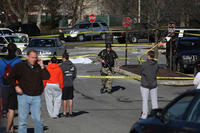-
NORAD is ready to track Santa's flight
The North American Aerospace Defense Command is getting ready to track Santa’s yuletide journey. The NORAD Tracks Santa Web site went live the other day featuring a Countdown Calendar, a Kid’s Countdown Village complete with holiday games and activities that change daily, and video messages from students and troops from around the world
-
-
NY counties receive money to prepare for emergencies
The magnitude of Hurricane Irene and Tropical Storm Lee posed serious communications challenges to the response and recovery efforts among many New York counties; these counties are now receiving $20 million in funding to help localities better respond to emergency situations
-
-
Facial recognition systems for Orange County, California

Hunter Systems will sell and configure up to thirty-one Hunter SmartShot systems to twenty police departments in Orange County and to the Orange County Sheriff’s Department
-
-
Death of fourteen bomb dogs sparks $1 million lawsuit

A firm that trains bomb sniffing dogs for law enforcement and military personnel is suing a transportation company for more than $1 million over the deaths of fourteen highly-trained canines bound for Afghanistan
-
-
Georgia readies portable hospitals
On Monday local health and emergency response officials from Georgia’s West Central Health District gathered to learn how to quickly set up a portable hospital in the event of an emergency
-
-
The Israeli military prepares for a new type of war
The Israel Defense Force (IDF) has created a new military command – the Strategic Depth Command; this new command, and the new, commando-heavy, look of the IDF’s higher echelon, should tell us that Israel is preparing for a new type of war; adversaries of Israel who have been entertaining the thought that sheer distance from Israel would offer them some protection, may want to think again
-
-
DHS helps New Mexico battle local gangs and cartels

In recent years, DHS has sent more and more federal agents and resources to New Mexico to help local law enforcement officials battle gangs, catch drug dealers, and other criminals; since 2009 DHS has deployed more than sixty agents to New Mexico and formed several joint task forces and multiagency groups
-
-
Rapid DNA test system nears completion
Thanks to an additional $40 million in funding, IntegenX is close to creating a real-time DNA analysis system; the company is currently working to complete a rapid DNA test kit that can provide law enforcement officials, government agencies, or forensic laboratories with real-time biometric identification
-
-
Jail installs facial recognition tool to prevent accidental releases
To prevent the accidental release of the wrong inmate, Madison County Jail in Alabama recently became the first prison in the United States to install 3D facial recognition technology
-
-
Measuring the effect of fire on materials
Researchers at Universidad Carlos III de Madrid (UC3M) are developing an infrared measuring method to analyze the thermal properties and resistance to fire of composite materials; this advance would have applications in areas where fire safety requires that the composite materials withstand high temperatures
-
-
Atlanta debuts new emergency communications systems
Last week first responders in Atlanta, Georgia gained a valuable new tool in helping to reduce 911 response times and improve communication during a disaster
-
-
The border fear index: How to measure border security
Both the administration and its critics rely on the FBI Uniform Crime Reports and on reported by the national media to make their arguments about how secure the U.S.-Mexican border is, and how to make it more secure; Lee Maril contends that the FBI report and the national media do not offer an accurate picture of the situation along the border because they are not nuanced enough; for example, they ignore the fear instilled in border-area residents by the cartels and the cartels’ collaborators, and they do not collect other relevant human behavior data
-
-
DHS helps diffuse Verizon emergency alert scare

Thanks to social media, DHS was able to help quickly diffuse an alarming situation for residents in New Jersey
-
-
New technology helps Virginia Tech avoid another massacre

Last week Virginia Tech officials made all the right decisions after a man killed a campus police officer, showcasing the valuable lessons it had learned following the 2007 Virginia Tech massacre that left thirty-two people dead and twenty-five injured
-
-
Technology helps Jersey police fight crime in real-time
In the last decade massive technological breakthroughs have made information more accessible than ever before and law enforcement agencies are increasingly taking advantage of new mobile technology to help fight crime
-
More headlines
The long view
AI-Controlled Fighter Jets May Be Closer Than We Think — and Would Change the Face of Warfare
Could we be on the verge of an era where fighter jets take flight without pilots – and are controlled by artificial intelligence (AI)? US R Adm Michael Donnelly recently said that an upcoming combat jet could be the navy’s last one with a pilot in the cockpit.
What We’ve Learned from Survivors of the Atomic Bombs
Q&A with Dr. Preetha Rajaraman, New Vice Chair for the Radiation Effects Research Foundation in Hiroshima and Nagasaki, Japan.
Need for National Information Clearinghouse for Cybercrime Data, Categorization of Cybercrimes: Report
There is an acute need for the U.S. to address its lack of overall governance and coordination of cybercrime statistics. A new report recommends that relevant federal agencies create or designate a national information clearinghouse to draw information from multiple sources of cybercrime data and establish connections to assist in criminal investigations.
Autonomous Weapon Systems: No Human-in-the-Loop Required, and Other Myths Dispelled
“The United States has a strong policy on autonomy in weapon systems that simultaneously enables their development and deployment and ensures they could be used in an effective manner, meaning the systems work as intended, with the same minimal risk of accidents or errors that all weapon systems have,” Michael Horowitz writes.
Twenty-One Things That Are True in Los Angeles
To understand the dangers inherent in deploying the California National Guard – over the strenuous objections of the California governor – and active-duty Marines to deal with anti-ICE protesters, we should remind ourselves of a few elementary truths, writes Benjamin Wittes. Among these truths: “Not all lawful exercises of authority are wise, prudent, or smart”; “Not all crimes require a federal response”; “Avoiding tragic and unnecessary confrontations is generally desirable”; and “It is thus unwise, imprudent, and stupid to take actions for performative reasons that one might reasonably anticipate would increase the risks of such confrontations.”
Luigi Mangione and the Making of a ‘Terrorist’
Discretion is crucial to the American tradition of criminal law, Jacob Ware and Ania Zolyniak write, noting that “lawmakers enact broader statutes to empower prosecutors to pursue justice while entrusting that they will stay within the confines of their authority and screen out the inevitable “absurd” cases that may arise.” Discretion is also vital to maintaining the legitimacy of the legal system. In the prosecution’s case against Luigi Mangione, they charge, “That discretion was abused.”
